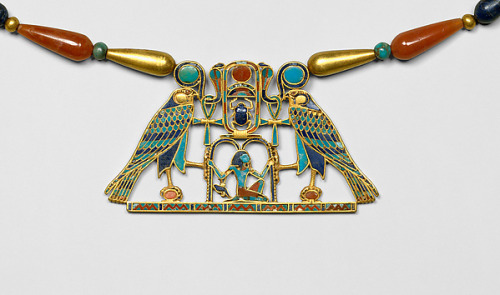theancientwayoflife:~Pectoral and Necklace of Sithathoryunet with the Name of Senwosret II.Period: M
theancientwayoflife:~Pectoral and Necklace of Sithathoryunet with the Name of Senwosret II.Period: Middle KingdomDynasty: Dynasty 12Reign: reign of Senwosret IIDate: ca. 1887–1878 B.C.Geography: From Egypt, Fayum Entrance Area, Lahun, Tomb of Sithathoryunet (BSA Tomb 8), Egypt Exploration Society excavations, 1914Medium: Gold, carnelian, lapis lazuli, turquoise, garnet (pectoral) Gold, carnelian, lapis lazuli, turquoise, green feldspar (necklace)This pectoral is composed around the throne name of King Senwosret II. It was found among the jewelry of Princess Sithathoryunet in a special niche of her underground tomb beside the pyramid of Senwosret II at Lahun. Hieroglyphic signs make up the design, and the whole may be read: “The god of the rising sun grants life and dominion over all that the sun encircles for one million one hundred thousand years [i.e., eternity] to King Khakheperre [Senwosret II].”This cloisonné pectoral is inlaid with 372 carefully cut pieces of semiprecious stones. The heraldic design is replete with symbolism. Zigzag lines on the base bar represent the primordial waters out of which the primeval hill emerged. Each of the falcons, symbols of the sun god, clasps a circular hieroglyph meaning “encircled,” thus declaring the solar deity’s supreme power over the universe. The same hieroglyph, elongated to form a cartouche, encircles the throne name of Senwosret II, Khakheperre. Flanking the king’s name are two ankh hieroglyphs (meaning “life”) suspended from cobras whose tails are wound around the sun disk on the falcons’ heads. These snakes represent Nekhbet and Udjo, the traditional protector goddesses of the king. Supporting the royal cartouche is the kneeling god Heh clutching two palm ribs symbolizing “millions of years.” Thus the king’s life and existence in time are described as part of a universe created and sustained by the supreme sun god.Jewelry worn by royal women during the Middle Kingdom was not simply for adornment or an indication of status but was also symbolic of concepts and myths surrounding Egyptian royalty. Jewelry imbued a royal woman with superhuman powers and thus enabled her to support the king in his role as guarantor of divine order on earth. It was essentially the king who benefited from the magical powers inherent in the jewelry worn by the female members of his family, which explains why his name, rather than that of the princess, appears in the designs.Since the tomb of the princess was beside the pyramid of Senwosret, scholars speculate that she was his daughter. Other items in the tomb bear the name of Amenemhat III, suggesting that the princess lived during the reigns of three of the most powerful rulers of Dynasty 12: Senwosret II, Senwosret III, and Amenemhat III. -- source link
Tumblr Blog : theancientwayoflife.tumblr.com


